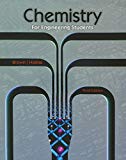
Bundle: Chemistry for Engineering Students, 3rd, Loose-Leaf + OWLv2 with QuickPrep 24-Months Printed Access Card
3rd Edition
ISBN: 9781305367388
Author: Lawrence S. Brown, Tom Holme
Publisher: Cengage Learning
expand_more
expand_more
format_list_bulleted
Question
Chapter 14, Problem 14.76PAE
Interpretation Introduction
Interpretation:
Design and describe an experiment that demonstrates whether legume takes up Cu2+ from water.
Concept Introduction:
Geiger counter: It is an instrument used for detecting and measuring ionizing radiations. It can detect the ionizing radiation like alpha particle, gamma particle and beta particle with the use of the ionization effect.
Expert Solution & Answer
Want to see the full answer?
Check out a sample textbook solution
Students have asked these similar questions
what is the skeletal structure of a tertiary alkyl fluoride with six carbon atoms and no rings.
One step of glycolysis is a retro-aldol reaction (aldolase) to produce ATP.Below is the aldol reaction of the equilibrium. Show the mechanism for the base catalyzed reaction. *see image
Provide the missing information. *see image
Chapter 14 Solutions
Bundle: Chemistry for Engineering Students, 3rd, Loose-Leaf + OWLv2 with QuickPrep 24-Months Printed Access Card
Ch. 14 - Prob. 1COCh. 14 - Prob. 2COCh. 14 - Prob. 3COCh. 14 - Prob. 4COCh. 14 - Prob. 5COCh. 14 - Prob. 6COCh. 14 - Prob. 7COCh. 14 - Prob. 8COCh. 14 - Prob. 9COCh. 14 - Prob. 10CO
Ch. 14 - Prob. 14.1PAECh. 14 - Prob. 14.2PAECh. 14 - Prob. 14.3PAECh. 14 - Prob. 14.4PAECh. 14 - (a) How does 14C enter a living plant? (b) Write...Ch. 14 - Prob. 14.6PAECh. 14 - Prob. 14.7PAECh. 14 - Prob. 14.8PAECh. 14 - Prob. 14.9PAECh. 14 - Prob. 14.10PAECh. 14 - Prob. 14.11PAECh. 14 - Prob. 14.12PAECh. 14 - Prob. 14.13PAECh. 14 - Prob. 14.14PAECh. 14 - Prob. 14.15PAECh. 14 - Prob. 14.16PAECh. 14 - Prob. 14.17PAECh. 14 - Prob. 14.18PAECh. 14 - Prob. 14.19PAECh. 14 - Prob. 14.20PAECh. 14 - Prob. 14.21PAECh. 14 - Prob. 14.22PAECh. 14 - Prob. 14.23PAECh. 14 - Prob. 14.24PAECh. 14 - Prob. 14.25PAECh. 14 - Prob. 14.26PAECh. 14 - Prob. 14.27PAECh. 14 - Prob. 14.28PAECh. 14 - Prob. 14.29PAECh. 14 - Prob. 14.30PAECh. 14 - Prob. 14.31PAECh. 14 - Prob. 14.32PAECh. 14 - Prob. 14.33PAECh. 14 - Prob. 14.34PAECh. 14 - Prob. 14.35PAECh. 14 - Prob. 14.36PAECh. 14 - Prob. 14.37PAECh. 14 - Prob. 14.38PAECh. 14 - Prob. 14.39PAECh. 14 - Prob. 14.40PAECh. 14 - Prob. 14.41PAECh. 14 - Prob. 14.42PAECh. 14 - Prob. 14.43PAECh. 14 - Prob. 14.44PAECh. 14 - Prob. 14.45PAECh. 14 - Prob. 14.46PAECh. 14 - Prob. 14.47PAECh. 14 - Prob. 14.48PAECh. 14 - Prob. 14.49PAECh. 14 - Prob. 14.50PAECh. 14 - Prob. 14.51PAECh. 14 - Prob. 14.52PAECh. 14 - Prob. 14.53PAECh. 14 - Prob. 14.54PAECh. 14 - Prob. 14.55PAECh. 14 - Prob. 14.56PAECh. 14 - Prob. 14.57PAECh. 14 - Prob. 14.58PAECh. 14 - Prob. 14.59PAECh. 14 - Prob. 14.60PAECh. 14 - Prob. 14.61PAECh. 14 - Prob. 14.62PAECh. 14 - Prob. 14.63PAECh. 14 - Prob. 14.64PAECh. 14 - Prob. 14.65PAECh. 14 - Prob. 14.66PAECh. 14 - Prob. 14.67PAECh. 14 - Prob. 14.68PAECh. 14 - Prob. 14.69PAECh. 14 - Prob. 14.70PAECh. 14 - Prob. 14.71PAECh. 14 - Prob. 14.72PAECh. 14 - Prob. 14.73PAECh. 14 - Prob. 14.74PAECh. 14 - Prob. 14.75PAECh. 14 - Prob. 14.76PAECh. 14 - Prob. 14.77PAECh. 14 - Prob. 14.78PAECh. 14 - Prob. 14.79PAECh. 14 - Prob. 14.80PAECh. 14 - Prob. 14.81PAECh. 14 - Prob. 14.82PAECh. 14 - Prob. 14.83PAECh. 14 - Prob. 14.84PAECh. 14 - Prob. 14.85PAECh. 14 - Prob. 14.86PAECh. 14 - Prob. 14.87PAECh. 14 - Prob. 14.88PAECh. 14 - Prob. 14.89PAECh. 14 - Prob. 14.90PAECh. 14 - Prob. 14.91PAECh. 14 - Prob. 14.92PAECh. 14 - Prob. 14.93PAECh. 14 - Prob. 14.94PAECh. 14 - Prob. 14.95PAECh. 14 - Prob. 14.96PAECh. 14 - Prob. 14.97PAECh. 14 - Prob. 14.98PAECh. 14 - Prob. 14.99PAECh. 14 - Prob. 14.100PAECh. 14 - Prob. 14.101PAECh. 14 - Prob. 14.102PAECh. 14 - Prob. 14.103PAE
Knowledge Booster
Similar questions
- Provide the missing information. *see imagearrow_forwardProvide the missing information. *see imagearrow_forwardDraw the mechanism (including all curved arrows for electron movement) showing how the maleicanhydride is attacked by the anthracene and formation of the final Diels Alder product.arrow_forward
- I have a bottle of butanal that has been improperly used by lab workers. They allowed a traceamount NaOH (aq) to contaminate the bottle. What is now in my bottle of “butanal? What is the molecular name and functional group name? Draw the structure.arrow_forwardProvide the missing information. *see imagearrow_forwardFirst image: Why can't the molecule C be formed in those conditions Second image: Synthesis for lactone C its not an examarrow_forward
arrow_back_ios
SEE MORE QUESTIONS
arrow_forward_ios
Recommended textbooks for you
 Chemistry: The Molecular ScienceChemistryISBN:9781285199047Author:John W. Moore, Conrad L. StanitskiPublisher:Cengage Learning
Chemistry: The Molecular ScienceChemistryISBN:9781285199047Author:John W. Moore, Conrad L. StanitskiPublisher:Cengage Learning Chemistry: Principles and ReactionsChemistryISBN:9781305079373Author:William L. Masterton, Cecile N. HurleyPublisher:Cengage Learning
Chemistry: Principles and ReactionsChemistryISBN:9781305079373Author:William L. Masterton, Cecile N. HurleyPublisher:Cengage Learning Chemistry for Engineering StudentsChemistryISBN:9781337398909Author:Lawrence S. Brown, Tom HolmePublisher:Cengage Learning
Chemistry for Engineering StudentsChemistryISBN:9781337398909Author:Lawrence S. Brown, Tom HolmePublisher:Cengage Learning Chemistry & Chemical ReactivityChemistryISBN:9781337399074Author:John C. Kotz, Paul M. Treichel, John Townsend, David TreichelPublisher:Cengage Learning
Chemistry & Chemical ReactivityChemistryISBN:9781337399074Author:John C. Kotz, Paul M. Treichel, John Townsend, David TreichelPublisher:Cengage Learning Chemistry & Chemical ReactivityChemistryISBN:9781133949640Author:John C. Kotz, Paul M. Treichel, John Townsend, David TreichelPublisher:Cengage Learning
Chemistry & Chemical ReactivityChemistryISBN:9781133949640Author:John C. Kotz, Paul M. Treichel, John Townsend, David TreichelPublisher:Cengage Learning Chemistry for Engineering StudentsChemistryISBN:9781285199023Author:Lawrence S. Brown, Tom HolmePublisher:Cengage Learning
Chemistry for Engineering StudentsChemistryISBN:9781285199023Author:Lawrence S. Brown, Tom HolmePublisher:Cengage Learning

Chemistry: The Molecular Science
Chemistry
ISBN:9781285199047
Author:John W. Moore, Conrad L. Stanitski
Publisher:Cengage Learning

Chemistry: Principles and Reactions
Chemistry
ISBN:9781305079373
Author:William L. Masterton, Cecile N. Hurley
Publisher:Cengage Learning

Chemistry for Engineering Students
Chemistry
ISBN:9781337398909
Author:Lawrence S. Brown, Tom Holme
Publisher:Cengage Learning

Chemistry & Chemical Reactivity
Chemistry
ISBN:9781337399074
Author:John C. Kotz, Paul M. Treichel, John Townsend, David Treichel
Publisher:Cengage Learning

Chemistry & Chemical Reactivity
Chemistry
ISBN:9781133949640
Author:John C. Kotz, Paul M. Treichel, John Townsend, David Treichel
Publisher:Cengage Learning

Chemistry for Engineering Students
Chemistry
ISBN:9781285199023
Author:Lawrence S. Brown, Tom Holme
Publisher:Cengage Learning